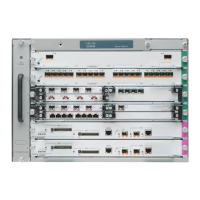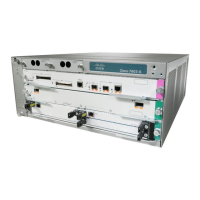Send document comments to nexus7k-docfeedback@cisco.com
3-17
Cisco Nexus 7000 Series NX-OS Interfaces Configuration Guide, Release 5.x
OL-23435-03
Chapter 3 Configuring Layer 2 Interfaces
Configuring Access and Trunk Interfaces
This example shows how to add VLANs 15 to 20 to the list of allowed VLANs on the Ethernet 3/1, Layer
2 trunk port:
switch# configure terminal
switch(config)# interface ethernet 3/1
switch(config-if)# switchport trunk allowed vlan 15-20
switch(config-if)#
Configuring a Default Interface
The default interface feature allows you to clear the existing configuration of multiple interfaces such as
Ethernet, loopback, VLAN network, port-channel, and tunnel interfaces. All user configuration under a
specified interface will be deleted. You can optionally create a checkpoint before clearing the interface
configuration so that you can later restore the deleted configuration.
Note The default interface feature is not supported for management interfaces because the device could go to
an unreachable state.
Step 3
switchport trunk allowed vlan {vlan-list
add vlan-list | all |except vlan-list |
none | remove vlan-list}
Example:
switch(config-if)# switchport trunk
allowed vlan add 15-20#
Sets the allowed VLANs for the trunk interface. The
default is to allow all VLANs on the trunk interface: 1
to 3967 and 4048 to 4094. VLANs 3968 to 4047 are the
default VLANs reserved for internal use by default. By
default, all VLANs are allowed on all trunk interfaces.
Beginning with Cisco Release 5.2(1), the default
reserved VLANs are 3968 to 4094, and you can change
the block of reserved VLANs. See the Cisco Nexus
7000 Series NX-OS Layer 2 Switching Configuration
Guide, Release 5.x, for more information.
Note You cannot add internally allocated VLANs as
allowed VLANs on trunk ports. The system
returns a message if you attempt to list an
internally allocated VLAN as an allowed
VLAN.
Step 4
exit
Example:
switch(config-if)# exit
switch(config)#
Exits the interface mode.
Step 5
show vlan
Example:
switch# show vlan
(Optional) Displays the status and information for
VLANs.
Step 6
copy running-config startup-config
Example:
switch(config)# copy running-config
startup-config
(Optional) Copies the running configuration to the
startup configuration.
Command Purpose

